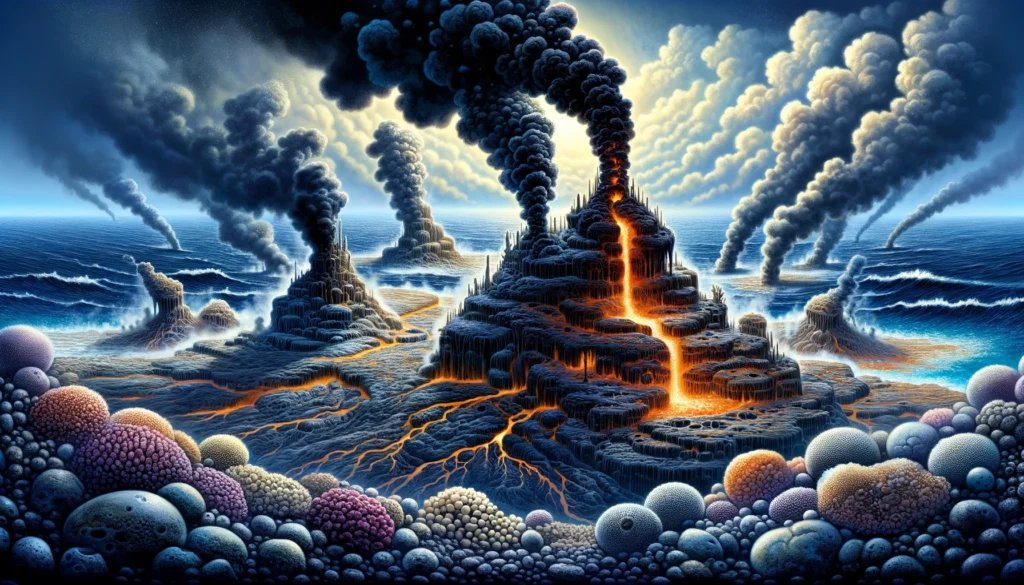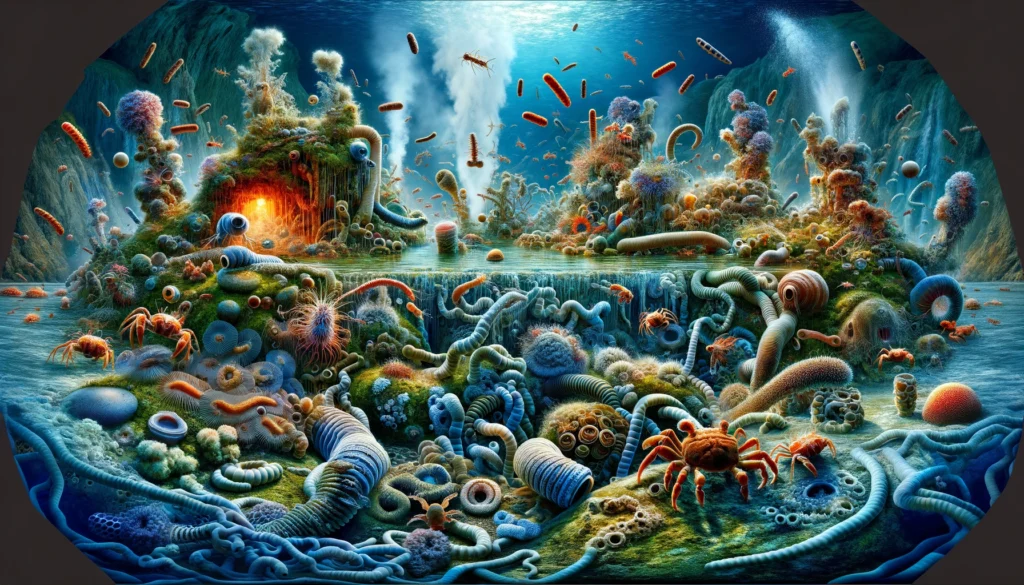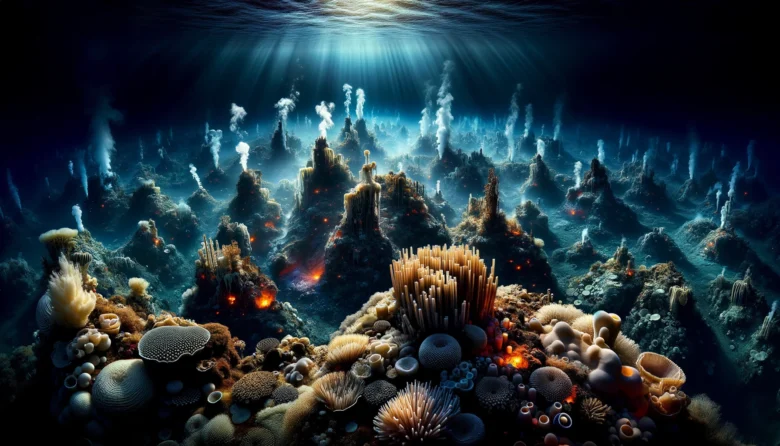Unveiling the Mysteries: Definition and Discovery of Hydrothermal Vents
- A Glimpse into the Abyss: What Are Hydrothermal Vents?
At first glance, the deep sea floor appears barren and lifeless, a vast expanse of mud and rock cloaked in perpetual darkness. Yet, in this seemingly desolate landscape, hydrothermal vents burst forth like fountains of life, offering a stark contrast to the surrounding deep-sea plain. These natural geysers are not just spectacular phenomena; they are windows into Earth’s fiery heart, ejecting superheated water from within the crust. This water, reaching scalding temperatures of over 400°C, carries with it a rich cocktail of minerals and chemicals, painting a vivid picture of the dynamic processes beneath the Earth’s surface.
- The Discovery That Changed Marine Science
The story of hydrothermal vents is as much a tale of technological triumph as it is of scientific curiosity. Prior to the 1970s, the deep ocean floor was a map waiting to be drawn, its features and inhabitants a mystery. The discovery of hydrothermal vents in 1977 by scientists aboard an American research submersible Alvin marked a pivotal moment in oceanography. It shattered the long-held belief that life could not exist in such extreme and inhospitable conditions, expanding our understanding of the possibilities of life on Earth, and potentially, other celestial bodies.

- Where Giants Reside: Locating Hydrothermal Vents
The quest to find hydrothermal vents leads us to the planet’s most volatile underwater landscapes, often near volcanically active sites, particularly along mid-ocean ridges. These ridges form a global network of mountain chains where tectonic plates part ways, creating new ocean floors and providing the perfect stage for the drama of hydrothermal vent formation. It is here, in these crucibles of creation, that the Earth’s inner heat fuels the formation of vents, supporting lush oases of life in the deep-sea desert.
Exploring the Inferno: Characteristics of Hydrothermal Vents
- The Fiery Architecture: Physical Features of Hydrothermal Vents
Dive deeper into the abyss, and you’ll encounter the architectural marvels of the deep sea: the hydrothermal vents. These structures are not merely cracks on the ocean floor but are complex formations resembling towering chimneys, known as “black smokers.” These black smokers are the skyscrapers of the deep, rising from the seafloor and belching out clouds of mineral-rich water so hot it seems to defy the frigid temperatures of the deep ocean. The water at these vents can soar to 400°C or more, creating an otherworldly spectacle as it contrasts with the near-freezing surrounding waters.
The minerals carried by this superheated water precipitate upon contact with the cold ocean, forming chimney-like structures that can grow to towering heights. These vents are not static; they are dynamic features of the ocean floor, constantly changing, growing, and collapsing, creating a landscape as dynamic and volatile as any found on the surface world.

- A Chemical Cauldron: The Chemical Environment of Hydrothermal Vents
Venturing into the chemistry of hydrothermal vents reveals a cauldron of life-sustaining processes. The fluid ejected from these vents is not merely seawater but a chemical broth enriched with minerals and compounds such as hydrogen sulfide, methane, and various metals. This environment is a chemical powerhouse, where the usual rules of marine life are turned on their head.
The vents’ effluent is rich in substances like hydrogen sulfide, the same gas that gives rotten eggs their foul odor, yet it is this seemingly inhospitable chemical that fuels the lush communities of vent organisms. The vents act as chemical reactors, where the interaction between the hot vent fluid and the cold seawater creates a rich tapestry of chemical reactions, providing the energy and materials necessary for life to thrive in the absence of sunlight.
Life in the Extremes: Ecological Significance of Hydrothermal Vents
- A Hotbed of Biodiversity: Life at Hydrothermal Vents
In the shadowy depths, where the sun’s rays are a distant memory, hydrothermal vents illuminate the ocean floor with life. These vents are not barren outposts of geothermal activity but thriving ecosystems, bursting with biodiversity that rivals tropical rainforests. Here, in the harsh conditions of extreme pressure and temperature, life has found a way to not just survive, but flourish.
The inhabitants of these deep-sea communities are as fascinating as they are diverse. Giant tube worms, which can grow several meters long, dominate the vent landscapes, waving like banners in the vent’s effluent. Clams and mussels cluster around the bases of the vents, and swarms of shrimp navigate the mineral-laden waters. Each species has adapted in remarkable ways to harness the energy of the vents, contributing to a complex and productive ecosystem.

- Chemosynthesis: The Engine of Life in the Darkness
At the heart of these bustling communities is a process as fundamental as it is extraordinary: chemosynthesis. In stark contrast to the sun-drenched surfaces of the Earth where life relies on photosynthesis, the organisms at hydrothermal vents draw their energy from the chemicals belched forth by the Earth itself. Microorganisms at the base of the food web convert chemicals like hydrogen sulfide and methane from the vent fluids into usable energy, forming the cornerstone of a food web that sustains a variety of life forms in complete darkness.
This process of chemosynthesis not only supports the diverse array of organisms found at these vents but also challenges our understanding of life’s boundaries, demonstrating that life can thrive under conditions previously thought uninhabitable. The ability of these organisms to harness chemical energy paves the way for a complex ecosystem, offering profound insights into the adaptability and resilience of life.
Unlocking the Deep: Research and Discoveries at Hydrothermal Vents
- Venturing into the Unknown: Scientific Investigations
The exploration of hydrothermal vents is a saga of technological ingenuity and human curiosity. Accessing these remote, high-pressure environments deep beneath the ocean’s surface requires sophisticated technology. Remotely operated vehicles (ROVs) and manned submersibles, like the famed Alvin {deep-diving research submersible capable of bringing humans to the seafloor at depths as great as 4,500 meters (2.8 miles)}, are the workhorses of deep-sea exploration, equipped with cameras, robotic arms, and an array of sensors to study the vents’ complex ecosystems and geophysical characteristics. These underwater explorers allow scientists to collect samples, observe living organisms, and map the terrain of the ocean floor, providing invaluable insights into the workings of these dynamic systems.

- Revelations of the Abyss: Biological and Geological Insights
The study of hydrothermal vents has yielded discoveries that have reshaped our understanding of the natural world. Biologically, these sites are goldmines of diversity, home to species found nowhere else on Earth. Many organisms discovered at hydrothermal vents, such as the giant tube worms and heat-tolerant microbes, have unique adaptations that enable them to thrive in extreme conditions, offering clues to the mechanisms of evolution and survival in hostile environments.
Geologically, hydrothermal vents have illuminated aspects of the Earth’s inner workings, from the processes of plate tectonics to the formation of mineral deposits. They serve as natural laboratories for studying the Earth’s sub-sea-floor processes, including how the planet’s crust is formed and the way heat and chemicals are cycled from the Earth’s interior to its surface. These insights have profound implications, extending our knowledge of Earth’s geology and enhancing our understanding of other planetary bodies with similar conditions.
Crucibles of Creation: The Importance of Hydrothermal Vents
- Vital Players in Earth’s Biogeochemical Cycles
Hydrothermal vents are not merely isolated phenomena on the ocean floor; they are integral components of the Earth’s biogeochemical cycles. These underwater fissures contribute significantly to the global budget of certain chemicals, including sulfur and iron. The vent fluids, enriched with minerals and elements, mix with ocean water, dispersing nutrients and influencing chemical compositions far beyond their immediate surroundings.
This circulation of elements between the crust and the ocean plays a critical role in shaping the chemistry of seawater and the availability of nutrients, essential for the broader marine ecosystem. The vents act as natural laboratories, helping scientists understand the complex processes that govern the Earth’s surface and interior, from mineral deposition to the cycling of crucial elements.

- Origins of Life and the Hydrothermal Vent Theory
Perhaps the most tantalizing aspect of hydrothermal vent research is its implications for the origins of life on Earth. The unique conditions at these vents, with their rich chemical environments and energy sources, present a compelling setting for the chemical reactions that may have led to the first forms of life. According to the hydrothermal vent theory, the complex organic molecules necessary for life could have formed in the protective and nutrient-rich environments of these vents.
This hypothesis suggests that life began not in shallow pools or the surface, but in the deep sea, under extreme conditions that promoted the synthesis of organic compounds. The vents provide a stable, energy-rich environment, where the building blocks of life could assemble and evolve into more complex organisms. This theory not only deepens our understanding of life’s potential beginnings on Earth but also expands the search for life in the universe, suggesting that similar conditions on other planets could harbor life.
At Risk Depths: Conservation and Threats to Hydrothermal Vents
- Environmental Impact: The Threats to Hydrothermal Ecosystems
Despite their remote location, hydrothermal vents are not immune to human impact. Deep-sea mining poses a significant threat to these fragile ecosystems, as the extraction of minerals and metals can lead to habitat destruction and pollution. The unique and slow-growing communities at hydrothermal vents, which rely on the stability and specific conditions of their environment, can be decimated by such activities.
Furthermore, climate change adds another layer of threat, altering ocean chemistry and potentially disrupting the intricate balance of life at these vents. The changes in seawater temperature, acidity, and circulation patterns could have far-reaching effects on the delicate ecosystems around hydrothermal vents, threatening their survival and the biodiversity they support.

- Guardians of the Deep: Conservation Efforts for Hydrothermal Vents
Recognizing the unique scientific and ecological value of hydrothermal vents, international agreements, and marine protected areas have been established to safeguard these underwater treasures. Conservation efforts aim to balance scientific exploration and commercial interests with the need to protect the vents’ biodiversity and ecological functions.
These initiatives often involve global cooperation, as hydrothermal vents are located in international waters, necessitating collective action for effective management and protection. The challenge is to ensure that these ecosystems are preserved for future generations, allowing us to continue learning from their untapped scientific potential and natural wonder.
Conclusion: The Enigma of Hydrothermal Vents and Their Global Significance
Hydrothermal vents stand as beacons of life in the deep sea, illuminating the ocean floor with their extraordinary ecosystems and geological phenomena. These remarkable structures are not only marvels of the natural world but also key players in the Earth’s biological and geological systems. Their discovery has expanded our understanding of life’s resilience, revealing that life can thrive in the most extreme conditions imaginable.
The study of hydrothermal vents has provided invaluable insights into the dynamics of Earth’s interior, the complexities of marine ecosystems, and the possibilities of life’s origins. These deep-sea vents challenge our preconceived notions about where and how life can exist, offering clues to the enduring mystery of life’s beginnings on our planet and possibly beyond.

However, the future of these unique ecosystems is under threat from human activities such as deep-sea mining and the overarching impacts of climate change. The need to protect these natural wonders is urgent, requiring global collaboration and dedicated conservation efforts to ensure they continue to thrive and enlighten us with their hidden secrets.
In closing, hydrothermal vents encapsulate the wonder and complexity of the natural world. Their study not only enhances our understanding of marine science but also underscores the interconnectedness of life, Earth’s processes, and the importance of safeguarding our planet’s extraordinary biodiversity. As we continue to explore and understand these fascinating undersea phenomena, we must also commit to their preservation for the enlightenment of future generations and the ongoing quest for knowledge in the vast, uncharted waters of our blue planet.
Author’s Note
Thank you for joining me on this journey into the depths of our planet’s oceans, where the enigmatic world of hydrothermal vents unfolds. These remarkable features of the deep sea not only challenge our understanding of life’s boundaries but also underscore the resilience and adaptability of nature. As we continue to explore these hidden frontiers, let’s remain committed to their preservation and the pursuit of knowledge they offer. Your interest and curiosity fuel the ongoing exploration and conservation of these underwater wonders.
G.C., Ecosociosphere contributor.
References and Further Reading:
- “The Ecology of Deep-Sea Hydrothermal Vents” by Cindy Lee Van Dover – This book provides a comprehensive overview of the unique ecosystems found at hydrothermal vents, offering insights into the biology and geology of these deep-sea features.
- “The Vent and Seep Biota: Aspects from Microbes to Ecosystems” edited by Steffen Kiel – A detailed exploration of the life forms inhabiting hydrothermal vents and cold seeps, highlighting the diversity and ecological significance of these environments.
- “Hydrothermal Vents: Cradle of Life on Earth and Beyond?” by Deborah S. Kelley – An intriguing look at the role of hydrothermal vents in theories of the origin of life, examining the conditions that foster the development of complex biological communities.





Comments
Thanks for sharing. I read many of your blog posts, cool, your blog is very good.
Can you be more specific about the content of your article? After reading it, I still have some doubts. Hope you can help me.
Can you be more specific about the content of your article? After reading it, I still have some doubts. Hope you can help me.
Your point of view caught my eye and was very interesting. Thanks. I have a question for you.
Your point of view caught my eye and was very interesting. Thanks. I have a question for you.